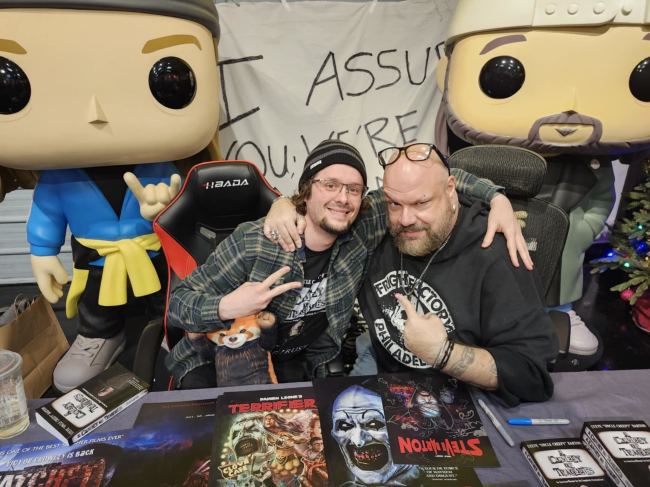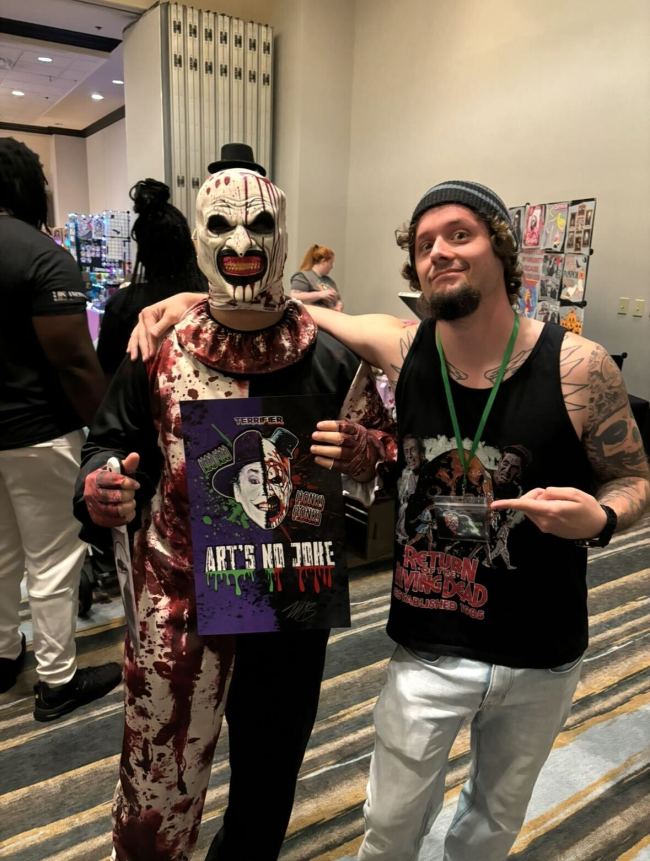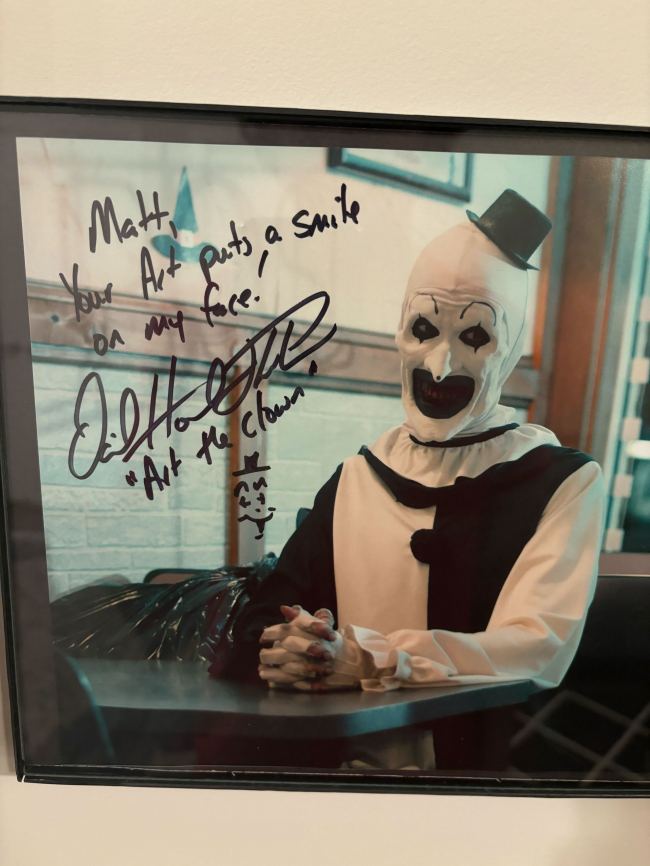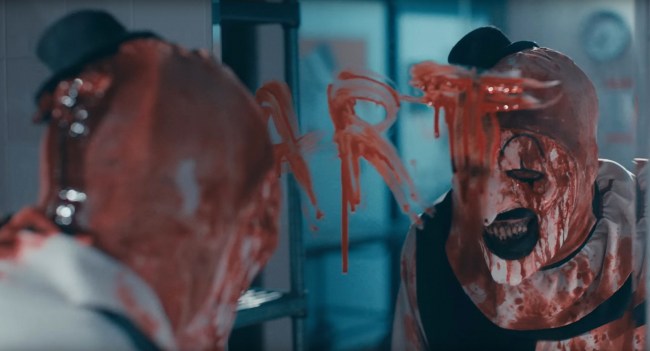It’s been 11 days since “Terrifier” actress Catherine Corcoran filed suit against filmmaker Damien Leone and producer Phil Falcone for breach of contract. Citing a document already in evidence with a Los Angeles federal court, the plaintiff’s team claims Corcoran is entitled to 1 percent of total franchise profits. That includes not just the ticket sales for the first three “Terrifier” movies — grossing more than $102 million worldwide — but also the intense surge of merchandising and licensing deals that have since emerged out of the ultra-violent slasher series and its iconic killer, Art the Clown.
The civil case isn’t likely to start in earnest until early next year, but news of Corcoran’s filing has already inspired other sources to come forward with their own complaints about Leone and Falcone’s business practices. IndieWire has spoken to multiple artists and businesses who say they were misled by the filmmaker, his producer, or both. They say they provided significant uncredited or uncompensated design work before being abruptly excluded from the “Terrifier family.”
Leone and Falcone fiercely denied Corcoran’s accusations through The Hollywood Reporter, but neither individual nor their shared defense counsel responded to IndieWire’s repeated requests for comment on the actress’ lawsuit or the subsequent claims IndieWire has already reported. They similarly did not respond to our inquiries about this article. Matt Bolea leads the charge among visual artists and graphic designers who take issue with “Terrifier” and the treatment of its fans.
Many would not agree to be formally interviewed, citing fears of legal and social retaliation. Bolea says he already experienced that on social media thanks to “Terrifier” and has “nothing to lose” now. “I know that the ‘Terrifier’ guys can see this, and I know that they know that I’m still out here,” Bolea told IndieWire. “I want them to know they did not silence me.”
“They completely ruined my outlook on that franchise.”
Steve Barton, better known as “Uncle Creepy” online, spoke out shortly after Corcoran filed her claim and encouraged IndieWire to connect with Bolea. Dread Central co-founder and former editor-in-chief Barton was an established industry professional in the genre community long before his site’s distribution label, Dread Presents, acquired the original “Terrifier” movie in late 2017. Barton has argued “Terrifier” wouldn’t be what it is today without him, and he’s found a sympathetic audience online where many fans still associate Uncle Creepy with the smash-hit indie film’s grassroots success.
 (Left to right): Matt Bolea and Steve ‘Uncle Creepy’ BartonCourtesy Matt Bolea
(Left to right): Matt Bolea and Steve ‘Uncle Creepy’ BartonCourtesy Matt Bolea
By many accounts, Barton was the professional foothold Leone and Falcone needed when they were still industry “outsiders” pedaling a controversial product. Then, he says he got forced out.
Bolea and others contend Leone used that same script once “Terrifier” was successful and say they suffered from that same power dynamic. Several claim the franchise approached them — artists who had only drawn Art the Clown for fun before — encouraging and benefiting from their work before shutting them down without compensation or partnership.
Bolea’s story is similar and centers around what he perceived to be the wider influence of the broader “Terrifier” team and community.
Many artists said they did not feel like they knew enough about the film business to question Leone and, much like distributor Barton, they believed the director would take care of them professionally as “Terrifier” grew. Barton and Corcoran’s claims each reflect the same sense of confusion these talented film fans say they now feel over Leone and Falcone’s behavior. Bolea views things more clearly.
“They completely ruined my outlook on that franchise,” he said. “You don’t want to ruin these movies for all the other fans that really bought into it, but at the end of the day, a lot of that just isn’t right.”
Multiple sources described themselves as feeling “stupid,” “naïve,” or “embarrassed” for not insisting on contracts before beginning their respective “Terrifier” projects. However, a representative for a well-established merchandising company (who asked to remain anonymous) told IndieWire they were “not surprised” by allegations of uncredited and uncompensated artwork surrounding the “Terrifier” fandom.
IndieWire has also learned of at least one dispute between Leone, Falcone, and an unnamed freelance artist that was settled out of court earlier this year. The terms of the agreement are not public, and the extent of the work covered by that deal is unknown.
“I was just doing stupid Art the Clown designs to not feel miserable in my life.”
Bolea, who first gained attention from the “Terrifier” fandom through the official “Art the Clown Appreciation Society” Facebook page, says he was “slandered” by the people who moderated the private Facebook group for the “Terrifier” team. Founded in 2018 just as the film series was kicking off, ATCAS has close to 45,000 members and remains one of the liveliest “Terrifier” platforms on the internet today. At the start, Bolea says he saw ATCAS primarily as a place to connect with other horror lovers and share his favorite Art the Clown drawings. Since then, it’s turned into an epicenter of turmoil and heartbreak.
“I was just doing stupid Art the Clown designs to not feel miserable in my life,” Bolea said. He described having a depression brought on by a recent divorce and his father’s cancer diagnosis that was alleviated by his enjoyment of Leone’s extreme horror films and continued, “Posting them on Facebook, that was just my thing.”
After Bolea’s designs gained traction in the group, he began receiving requests for t-shirts, which he didn’t know how to make at the time. One design featuring Art the Clown mixed with Batman’s Joker was particularly well-liked. When Bolea finally did learn to print his own apparel, he sent one of the group’s official moderators (who had an acting role in “Terrifier 2”) a free shirt to give to star David Howard Thornton — aka Art the Clown himself — at a convention. In return, Bolea said he got two videos. One of Thornton receiving the shirt from the ATCAS admin, and another, the actor sent Bolea on his own, complimenting the design. IndieWire has seen that video, which includes Thornton remarking that he might even “put [Bolea] in business.”
 Matt Bolea and a ‘Terrifier’ fan with a poster featuring one of his designsCourtesy Matt Bolea
Matt Bolea and a ‘Terrifier’ fan with a poster featuring one of his designsCourtesy Matt Bolea
Bolea said Thornton liked the shirt, which you can see the actor wearing in photos from meet-and-greet events spanning several months, and established Bolea as one of the most popular unofficial merch creators for the franchise. Thornton did not respond to our request for comment on this story, but IndieWire found proof of public interactions Bolea had with the actor, positioning them as enthusiastic supporters of each other’s work at a time when love for Art the Clown was spreading quickly.
“They started telling me all of this stuff and I was like, ‘Dog, I don’t need to know this.’”
Per Bolea, admins of the official fan group had to approve all posts, including links to Bolea’s merchandise store, he said, and they actively helped to promote his work, requested specific apparel designs, and bought a lot of it as well. Bolea places his story amid the exploding success of the two “Terrifier” sequels, released in 2022 and 2024. That’s a period of increasing interest to early franchise contributors like Corcoran and Barton, who say they were cut out of the “Terrifier” mania right as the low-budget project they championed became a phenomenon.
“I was seeing all these people buying and wearing my stuff, more than Terror Threads, more than Hell on Shirts, more than all these big, licensed companies at the time,” Bolea said. “I knew [the ‘Terrifier’ team] was aware of that. It was obvious. But it was also making me feel slightly problematic because I knew that without me having a license, that could affect the finances of other companies who had purchased the right to work with them. Here I am, just some guy coming in and taking their business.”
Bolea says the moderators — some of whom, based on screenshots reviewed by IndieWire, had access to “Terrifier” financial information — eventually approached him about an official “Terrifier” merchandising deal. The prospective agreement involved a hoodie Bolea created featuring Corcoran’s image specifically. The design had a zipper down the front that “cut” the actress in half, nodding to the way her character Dawn dies in the first film.
Bolea told IndieWire the ATCAS team liked it, but when he approached Barton about official licensing — read our last “Terrifier” report in which Barton claims he was “fired” from his role with the franchise and later mischaracterized by the filmmakers as “just a fan” — Barton told Bolea he should instead approach Falcone. The producer ultimately shut the deal down and told him he wasn’t licensed to sell any more merchandise, a move the graphic artist found “confusing” and “frustrating.” But in a series of emails shared with IndieWire, Bolea clearly accepts Falcone and Leone’s decision.
“Art the Clown literally walks around with my designs on,” Bolea said. “They had to know what I was doing, but he totally shut it down.” The rejection came after the juggernaut theatrical success of “Terrifier 2,” which might explain the shift in tolerance for unofficial merch. But Bolea said admins on the ATCAS group had already promoted his hoodie (Bolea provided IndieWire with a screenshot of one such post), and fans repeatedly followed up with him asking about the status of the project.
 Catherine Corcoran in ‘Terrifier’Courtesy Everett Collection
Catherine Corcoran in ‘Terrifier’Courtesy Everett Collection
According to Bolea, the disappointment that followed inspired a few people within the innermost ATCAS circle to break ranks, sharing information about Leone and Falcone that changed how Bolea sees the films. “They started telling me all of this stuff and I was like, ‘Dog, I don’t need to know this,’” he said.
Bolea told IndieWire he was disturbed by the extent of the in-fighting between ATCAS and the core “Terrifier” team, sharing screenshots of moderators viciously disparaging a number of people — including Falcone. Bolea said he later learned from a licensee that Falcone was insisting on a 35-percent royalty fee across Art the Clown and “Terrifier” merchandise. Manufacturers familiar with this type of competitive product space typically place IP royalties closer to 12 or 15 percent and stress that such a model would likely be “unsustainable.”
In the emails between Falcone and Bolea (provided to IndieWire by Bolea), the artist offers a 20 percent cut of all proceeds to the “Terrifier” filmmakers unprompted.
“From what I’m aware of, it did hurt a lot of smaller business partners they had because they couldn’t continue to make merchandise off of 35 percent retail,” Bolea said. “You’re just making no money.”
“It’s always been fans first. People like me don’t exist without them.”
Explaining how the behind-the-scenes drama soured his experience as a fan, Bolea said he ended up feeling cheated, not out of a deal but out of the community that had drawn him to “Terrifier” in the first place. As he began responding to questions about future sales, which were finished at that point, Bolea says the ATCAS moderators turned the verbal fire hose on him.
He shared many screenshots with IndieWire that paint the picture of an intense campaign intended to portray him and others who took issue with Falcone and Leone as obsessive, even delusional “Terrifier” fans who were seeking credit and compensation they were never owed. The screenshots provided by Bolea include members likening him to a serial killer and “a child throwing a tantrum,” further characterizing him as “pathetic” and indirectly threatening him with violence. On the contrary, Bolea said he acted in overwhelming good faith.
“I even helped them gather ‘Terrifier 3’ movie posters from multiple theaters after the ‘Terrifer 2′ re-release, so they wouldn’t be thrown away,” he said. “I sent them out to well over a hundred people who could not make the screenings, for free. Do you know how much money I could have made on eBay during that time if I was watching out for myself more than them? And that was the ATCAS admins’ idea.”
 An autographed photo Matt Bolea says he was given by David Howard ThorntonCourtesy Matt Bolea
An autographed photo Matt Bolea says he was given by David Howard ThorntonCourtesy Matt Bolea
The perception that Bolea was just an out-of-touch fan was further inflamed by his decision to share and “satirize” his experience with Leone and Falcone on Instagram and TikTok. He posted several videos that indirectly explained what happened to the potential sweatshirt release through light-hearted humor, before being banned from the group altogether. It was at that point that he began speaking out directly.
“I feel like if what happened to me hadn’t happened then, there wouldn’t be a basis to see what was really going on with ‘Terrifier’ fans and marketing in this gray area,” said Bolea.
Barton shared a similar experience with IndieWire last week. Of course, the former Dread Central editor-in-chief boasts a professional resume that directly contradicts the suggestion that he was just another “Terrifier” fan.
“When it comes to my relationship with the fans, it’s always been fans first. People like me don’t exist without them,” Barton said. “I’ll tell you this: A person or group can write or use all the right words regarding something, but if they don’t have the heart to back it up sooner or later, it will eventually ring false.”
“The franchise has done so much for the fanbase and for the industry,” said Bolea, who despite his history with “Terrifier” still hopes to see a fourth installment reach theaters. “There are so many people who have rightfully gotten success because of ‘Terrifier,’ like David [Howard Thornton] and Lauren [LaVera], but I feel like there should still be accountability when others are hurt or done wrong.”



